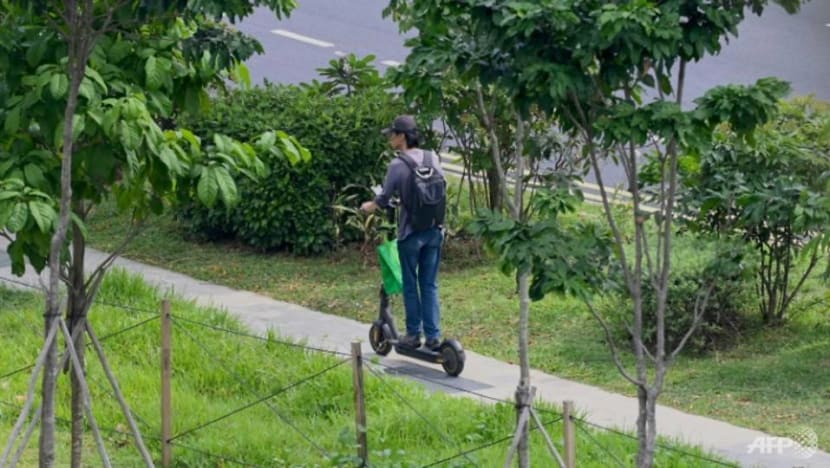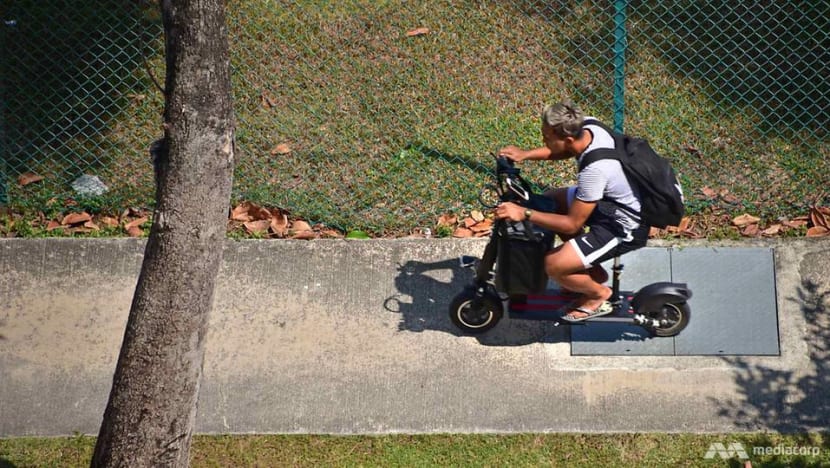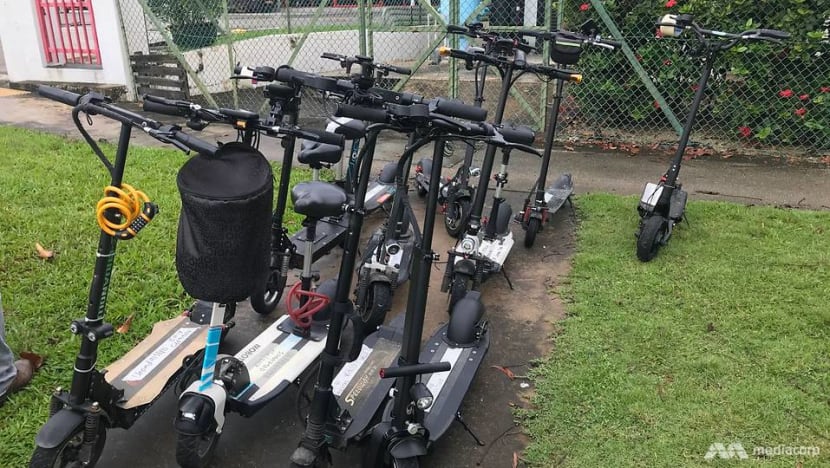commentary Commentary
Commentary: The PMD problem in Singapore is not just about jostling for space
It's not about space. To deal with Personal Mobility Devices effectively, we first need to look hard at why we lack basic consideration for others, says Cherie Tseng.

An e-scooter on a footpath in Singapore. (File photo: AFP/Roslan Rahman)
SINGAPORE: She was late for work, and uncharacteristically so.
Perhaps there was a traffic delay but she would have called to give the office a heads up. We gave it another half hour and the manager rang her on her handphone but no reply.
By half past nine, we called her home to check in on her. No answer.
It was past lunchtime before her husband called the manager back. Our colleague had been hit by an errant, slightly supped up e-scooter while crossing the road to work.
She was five months pregnant. She survived. The baby did not.
PMD ISSUES IN THE LION CITY
The conversation, discussion and debate over Personal Mobility Devices (PMDs) have always been fairly heated with proponents and opponents of equal measure.
I wonder if things were similar when automobiles first begun sharing the roads with horses and rickshaws; a new way of mobility jostling for space.
READ: Jail for PMD rider who said 'it's not your father's road' before assaulting strolling couple
Statistics put reported PMD accidents on public paths in 2017 and 2018 at 228. Of that, over 85 per cent of the reported accidents involved injuries, with 32 of those major injuries with concussions and fractures sustained. One person died.
In February last year, then Senior Minister of State for Transport Janil Puthucheary said in 2019 active mobility devices related offences were at an "unacceptable" 4,900 incidences.

The Active Mobility Act came into play in early 2018 with speed and size limits prescribed for PMDs, as well as limits on where they could be used. The following year, after a spate of exploding battery units, Singapore would require PMDs to be UL2272 safety certified.
Town councils also moved to ban PMDs in void decks. PMD users must also keep left, give way to pedestrians, wear a bicycle helmet and cannot carry a pillion.
Still, even with these measures in place, accidents continued to occur and the effectiveness of PMD rules were called into question even in parliament, articulating what many Singaporeans were already lamenting.
The Land Transport Authority (LTA) themselves would state that despite “significant efforts” to regulate the use of such personal mobility devices (PMDs) using laws and to educate the public in using such devices responsibly, “offences relating to errant behaviour and incidents involving e-scooters remained on an upward trend”.
READ: IN FOCUS: The PMD footpath ban a year on - what has changed?
By the end of 2019, PMDs were banned from all footpaths and all PMDs needed to be registered with LTA by persons over 16 years of age with an online theory test to follow.
PMD ISSUES GLOBALLY
Where PMD issues are concerned, Singapore can commiserate with countries like Japan, Germany and France. Japan has classified PMDs as motorised, thus requiring license plates and side mirrors for all PMDs; Peru and Germany have already banned e-scooters from pedestrian paths.
Barcelona, in Spain, banned PMDs from pedestrian paths after one killed a woman. France has banned PMDs from pavements saying PMDs had brought "the law of the jungle" with them.
And if projected numbers are to be believed, the PMD industry is in its nascent stages. The global market for PMDs, even amid the COVID-19 crisis, is estimated at US$ 11.2 billion in 2020, is projected to reach a revised size of US$ 16.1 billion by 2027.
This means, PMD issues are not only going to persist, they are going to grow in scale, and frequency. And one can understand why. PMDs are a cheaper, more efficient alternative to cars and they require less effort than a bicycle. It enables everyone – from the executive in Shenton way to the food delivery worker to get to his destination quickly at very little cost.

So, we can’t wish this problem away. A report by The National Transport Commission of Australia frames it aptly: “All modes of transport carry some degree of accident risk,” the report says, noting it is “very difficult to quantify” how risky PMDs are because it depends on how they are used.
So, then, what’s there to be done?
REGISTER THE USERS, LICENSE THE RETAILERS
News coverage of PMD accidents and incidents always clarify that the PMD in question is often non-compliant. A low-hanging fruit would be for retailers selling PMDs to be licensed; and if anyone needs to take a theory and practical test, it should be the retailers.
READ: Safety a priority for PMD rental businesses, but insurance is a challenge for some
Last August, the courts fined, for the first time, a retailer for selling a non-compliant PMD with the retailer claiming they forgot to take down an outdated website offering, despite LTA officers seeing the units displayed prominently at the premises.
But given that there has been only one prosecution amidst a bevy of incidents begs the question as to how effective legislature even is, or if enforcement, given a rife C2C kind of marketplace, is even possible.
LIMITS TO ENFORCEMENT
The regulation of PMDs is, without a doubt, well intentioned and, perhaps, somewhat effective insofar as accident numbers have come down since PMDs were banned. Even the number of non-complaint e-scooters have lowered by about 32 per cent but that number still stands at a whopping 54,000.
In the parliament session Dr Puthucheary said there is a need “to send a stronger deterrent message” to (errant users), with increment of maximum penalties for certain offences.
Given the ubiquity of PMDs all over the island, do we realistically expect law enforcement to police to the island fringes?
Even the plan for an online theory test taking would need to circumvent the inevitable shadow marketplace of “enterprising” people offering to help others ace the test.
WHY WE CANNOT HAVE NICE THINGS
The current legislative trajectory on PMDs is typical, and perhaps even necessary, expected and perversely welcomed in this island nation used to overregulation.
However, research into collective punishment — where the group is punished for the actions of the errant few — suggests that this way of achieving behavioural compliance is ineffective, and damaging in the long term.
READ: Commentary: Banning bicycles from footpaths won’t make poor cycling habits disappear
Legally and morally, each person has ownership for their own actions and ought to bear the consequences of those actions individually.
But we only need to look at how shared bikes were treated, or how we need to tie the return of shopping carts to money to realise that Singapore — a country that tops out on many world lists — falls miserably short when it comes to something as simple as sharing well with others.
This seems to suggest a lack of humanity in our culture, as well as some form of social dysfunction when we consider how we perceive the entitlement of our rights to things as the driving force of all our actions.
EDUCATION AS A WAY TO GO
Philosophy asks us to consider if a tree falls in a forest and no one is around to hear it, does it make a sound?
In the same vein, if a driver runs a red light in the heart of a quiet suburb in the middle of the night, and no one witnesses it, is it still an infraction?
It is myopic to think that legislation can solve, what is, at the core, a behavioral and character issue for Singapore. Every suggestion to manage the “PMD menace” seems to fall somewhere along the “ban a little” to “ban a lot” spectrum; a heartbreaking reality that must make Singa the courtesy lion weep.

The scene doesn’t need more rules, or deterrence; it needs more education. And I don’t mean the current plan to educate users on the rules and code of conduct of how to better use the roads.
Shanghai’s successful bike sharing landscape received a boost: On top of positive and negative reinforcements, there was also a concerted city wide moral education programme in schools and community centers, games, community policing and even alignment with corporations.
READ: Commentary: Cycling great for going green but is still a pain in urban Singapore
READ: Commentary: What happened to caution and graciousness on the roads?
Likewise in Singapore, there needs to be a parallel conversation about how we can inspire a more gracious way of interacting with each other that goes beyond everyone simply signalling before you turn.
When surveys show that a large set of us that are afraid to be kind lest we somehow end up looking foolish in the process, the issues run deep into the fissures of our societal bedrock.
It is only in fixing our collective ways of being to a more gracious, kind, aware and considerate one, can we begin to understand that, be it where the park connector paths are concerned — or in life, that our collective Singapore whole is greater than the sum of our parts.
Cherie Tseng is Chief Operations Officer at a local fintech company, a mother of three and editor with The Birthday Collective.












